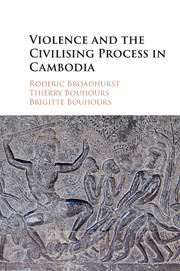Book contents
- Violence and the Civilising Process in Cambodia
- Violence and the Civilising Process in Cambodia
- Copyright page
- Contents
- Illustrations
- Figures
- Tables
- Preface
- Book part
- Glossary
- Map of Cambodia
- Introduction
- 1 Resistance of a peasant society
- 2 Patterns of premodern criminality
- 3 Development of the colonial state: modernisation and control
- 4 The ‘golden age’ of the Protectorate: 1920–1940
- 5 The anticolonial war: 1940–1955
- 6 The golden years of Sihanoukism: 1955–1966
- 7 Criminal states and civil wars: 1967–1975
- 8 The perfect storm: decivilising state and society: 1975–1979
- 9 Reconstruction in the midst of a civil war: pariahs, bandits, and international accomplices: 1979–1991
- 10 Crime and violence in contemporary Cambodia: 1991–2012
- 11 Civilising processes and violence in contemporary Cambodia
- 12 Discussion
- Book part
- References
- Index
- References
References
Published online by Cambridge University Press: 05 November 2015
- Violence and the Civilising Process in Cambodia
- Violence and the Civilising Process in Cambodia
- Copyright page
- Contents
- Illustrations
- Figures
- Tables
- Preface
- Book part
- Glossary
- Map of Cambodia
- Introduction
- 1 Resistance of a peasant society
- 2 Patterns of premodern criminality
- 3 Development of the colonial state: modernisation and control
- 4 The ‘golden age’ of the Protectorate: 1920–1940
- 5 The anticolonial war: 1940–1955
- 6 The golden years of Sihanoukism: 1955–1966
- 7 Criminal states and civil wars: 1967–1975
- 8 The perfect storm: decivilising state and society: 1975–1979
- 9 Reconstruction in the midst of a civil war: pariahs, bandits, and international accomplices: 1979–1991
- 10 Crime and violence in contemporary Cambodia: 1991–2012
- 11 Civilising processes and violence in contemporary Cambodia
- 12 Discussion
- Book part
- References
- Index
- References
- Type
- Chapter
- Information
- Violence and the Civilising Process in Cambodia , pp. 339 - 357Publisher: Cambridge University PressPrint publication year: 2015

